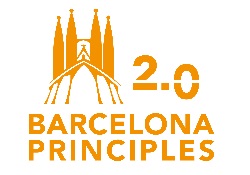by Marcus Brewster
PR practitioners often speak about the credibility factor of editorial publicity but the measurement thereof – the rudimentary ‘times three’ factorisation - is unsophisticated. As a whole, the PR industry’s reliance on AVE (Advertising Value Equivalence) as a base line for evaluation has made us vulnerable to close scrutiny.
This is not news to us. The global PR industry is very aware of the risk our often superficial reporting exposes us to. In an effort to address this, a global brains trust headed by the International Association for the Measurement and Evaluation of Communication developed a set of standardised reporting principles it dubbed the Barcelona Principles. Recently, we saw the release of an updated model: Barcelona 2.0.
Most notably, the principles call for a move away from AVE (again) and the measurement of outcomes, not just outputs. We are seeing this focus on achieving outcomes more and more through client requests and board-level directives.
Billing on outputs puts a greater focus on achieving results, instead of simply filling hours (inputs) with activities that don’t translate into anything meaningful. However, the holy grail is outcomes, in other words: how does PR Activity X make the company more profitable, or encourage staff retention or attraction, or make the phone ring or bring feet through the door?
Any marketing services provider who can link activities to outcomes, can confidently show the value of his work, and negotiate a greater share of the marketing budget based on tangible results. So in the PR channel, if the appearance of a specific piece of content coverage (a radio interview, a press release published online, a newspaper article) has led to 12 incoming sales queries, the next PR campaign review will be all the more meaningful.
However, agencies undermine themselves and the value they create for clients when PR contracts are structured around meaningless KPIs such as ‘X number of press releases developed per month’. Logic dictates that the PR effect (i.e. making the phone ring) arises from the placement or publication of the content, not in the backroom creation thereof. Why then do clients sign agency contracts that are structured around writing releases when they should be aligning the agencies to getting the coverage? These legacy PR contracts belong to a long-gone era that reduces PR to a box-ticking exercise. Especially when no premium is placed on the PR skill set of content placement.
PR contracts that emphasise content creation over placement puts the onus on the client to make himself available for regular interviews to enable the agency to create press release after press release that fall into the void of oblivion. And because agencies are not rewarded for maximising placement of the material, the job of securing placement often falls to junior PR staff who spam journalist inboxes in order to tick the box marked ‘distribution’.
PR outputs should be measured by their longevity and reach in an integrated model.
This encourages agencies to think carefully of how content is created, and forces them to really sweat the campaign collateral in order to wring every last bit of value out of it. It reduces wastefulness, and frees the client up to continue with his own work while the PR agency seeks to maximise the return on investment in creating that piece of content in the first place.
Like all businesses, PR agencies need to evolve to smarter ways of working. Adopting better reporting methodologies is a step in the right direction. But we also need to think carefully about how we structure our client agreements, lest we undermine the true value that smart PR brings.

Leave a Reply